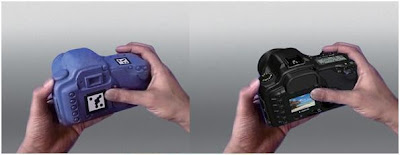Canon Mixed Reality Head-Mounted Display
Canon Mixed Reality
The Canon Mixed Reality headset can created detailed simulations and present them to the wearer as if they were highly detailed objects. Aimed at businesses who want to create products in a virtual world before the real one, it costs $125,000.You've heard of virtual reality and augmented reality, but are you ready for Mixed Reality? Canon hopes so, launching a new kind of product that blends the real world with imaginary objects via a sci-fi looking headset.
And when I say sci-fi, I mean old-school "Borg drone" sci-fi, lacking the minimalist and modern lines of . Google Glass Canon's Mixed Reality goggles are anything but sleek, amounting to a bulky headset that you tighten via crank, with a thick cord and antennae sticking out.
If it sounds like something you'd never buy, you're right, because you're not a business interested in simulating 3D renderings in actual space. If you were, say, a high-end automaker that does car design through 3D graphics and simulator rooms, then you'd be first in line. Canon Mixed Reality (a.k.a. MREAL) is aimed at businesses who want to see something virtually before it becomes real. (The video below explains more.)
Mixed Reality is similar to augmented reality, except that instead of seeing signposts with extra information (à la Nokia City Lens), Canon's headset simulates objects in space, in incredible detail. A room may be empty except for a chair, but sit down and put on the headset, and suddenly you're behind the wheel of a virtual sports car or helicopter. The simulation can be as detailed as the 3D rendering file that the headset is reading.
In addition, Canon's headset is just the wearable part of a platform. There's a software development kit for Mixed Reality, and developers will be able to create Minority Report-like experiences, where the wearer can actually interact with virtual objects via gesture. In any case, the headset system is still about a third of the cost of the simulator rooms many companies use today.
I got a chance to check out Canon Mixed Reality at a demo in New York City. Donning the headset for the first time, I was disappointed that there seemed to be a very slight lag in the virtual environment, almost like stop motion. The point of the product isn't to transport you to a sci-fi world, so that expectation probably wasn't fair, but nonetheless it was a bit jarring.
However, in looking around a virtual car for a few minutes, I could easily see the usefulness, kneeling down to look closely at the hubcaps, I could see good detail on the rims and tires. Then, before my eyes, the whole car changed color. Pushing my hand through the wheel, I saw it disappear beneath the virtual surface and felt for a second like Kitty Pryde.
Canon's pricey Mixed Reality concept may have a limited audience, but it's a very exclusive one. Being able to see, walk around and look closely at your product before it's even built will only appeal to a few specific industries, but for those businesses, it's pretty much the only game in town.
source :
http://mashable.com/2013/02/21/canon-mixed-reality/












0 komentar:
Posting Komentar